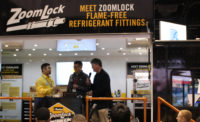The busy summer season has seen its fair share of ups and downs so far, but overall, HVACR distribution is in a good place.
According to Heating, Air-conditioning, and Refrigeration Distributors International (HARDI), average monthly sales for HARDI distributor members increased 15.9 percent in June 2016, and the average annualized growth from June 2015 to June 2016 was 7.2 percent. This annual growth rate has generally remained within the 6-7 percent range for most of the past two years.
Nationwide, this summer has been one of the hottest in recorded history. Per the National Oceanic and Atmospheric Administration (NOAA), the June temperature for the contiguous U.S. was 71.8°F, or 3.3° above the 20th century average. This was the warmest June on record and surpassed the previous record of 71.6° set in 1933.
The NOAA also noted that 17 states across the West, Great Plains, and parts of the Southeast had June temperatures that were much above average.
Tom Perić, editor of Distribution Center magazine, believes the outlook for the rest of the summer, and into 2017, is bright.
“Generally speaking, the economy looks positive for distributors and the industry, in general,” he said. “Gross domestic product is up, and we are going to see a better 2017 than 2016, according to one noted HVACR industry economist.”
Larry Trimbach, owner of 2-J Supply Co. in Dayton, Ohio, and HARDI’s regional director for the Great Lakes economic region, noted it has been a particularly topsy-turvy season in the Great Lakes region, but things have really picked up recently.
“Sales in May were down here in the Great Lakes region, but June flew up the charts,” he said. The staff at 2-J Supply and the region as a whole experienced a good July. It’s not quite as robust as June, but business was good.
“We are expecting 2016 to be a strong year and believe 2017 will be good, as well,” he continued. “We added a new location in Toledo, and we are kind of bullish on the economy right now. We also don’t feel like the election will put a damper on things too much, no matter the result.”
The results are consistent with other consumer, residential, and nonresidential building reports,” said Connor Lokar, senior economist, HARDI. “Existing and new home sales are doing well through the mid-point of the year. Housing starts overall are growing at a near-double digit pace, with single-family outperforming multifamily.”
REPAIRS AND TRENDS
Trimbach said customers are considering repairs and replacements, noting there is currently a good mix of both going on in the industry.
“As a distributor, we probably attract more repair-driven contractors,” he said. “Some of our competitors didn’t embrace repairs like we did, and it allows us to end up selling to people who aren’t regulars of ours in these times. To repair equipment doesn’t just include the cost of a coil and a condenser or whatever. It depends on how and where it is installed. It’s an important decision.”
According to Perić, a majority of distributors he has spoken with have said consumers are watching their dollars closely and leaning toward repairing systems.
In one such conversation, one distributor noted: “Dry-ship R-22 units are a very hot commodity. What does this mean? It implies that people are not installing new R-410a systems. This is probably why some OEMs are launching R-407c-rated condensing units, which allows them to replace R-22 condensing units and recharge the system with R-22. We are still repairing systems rather than replacing them.”
Perić also noted that replacement compressors are spiking upward, as well.
“As regulations continue to impact manufacturers, prices will continue to rise, which places a brake on replacement units for consumers,” he said.
Ductless technologies have certainly caught the interest of HVACR distributors.
“Mini splits have become a significant part of our business, and the same is true for our peers,” said Trimbach. “The trend has been to work toward higher SEER ratings. People have more knowledge now, and contractors are savvier in their sales approaches. Everyone is more knowledgeable overall.”
GOING DIGITAL
Contractors, distributors, manufacturers, customers, and everyone else associated with HVAC is becoming more technologically advanced and accepting that mobile devices are now a necessary part of doing business. Without a doubt, mobile applications are impacting every level of the HVAC supply chain, including the relationship between contractors and distributors.
“Mobile apps are certainly a differentiator right now,” said Brian Loftus, market research and benchmarking analyst, HARDI. “There is a lot of talk and concern about that.”
Perić believes it is just too early to tell what effect mobile applications are having, as there doesn’t seem to be enough data to make a factual assessment.
“What is true, however, is that distributors are aware that mobile access and the utility it provides is growing as contractors join the mainstream with their devices,” he said. “For example, more distributors have begun to make their websites mobile friendly. If they haven’t taken that step yet, they’re behind the curve.”
Trimbach said mobile applications can certainly make things less personal, but it’s imperative to stay ahead of what is happening in the industry.
“These apps help strengthen a distributor’s relationship with its contractors,” he said. “They also help a company get ahead of the trends, which reiterates that you’re doing what’s necessary to be successful.”
Publication date: 8/15/2016
Want more HVAC industry news and information? Join The NEWS on Facebook, Twitter, and LinkedIn today!







Report Abusive Comment